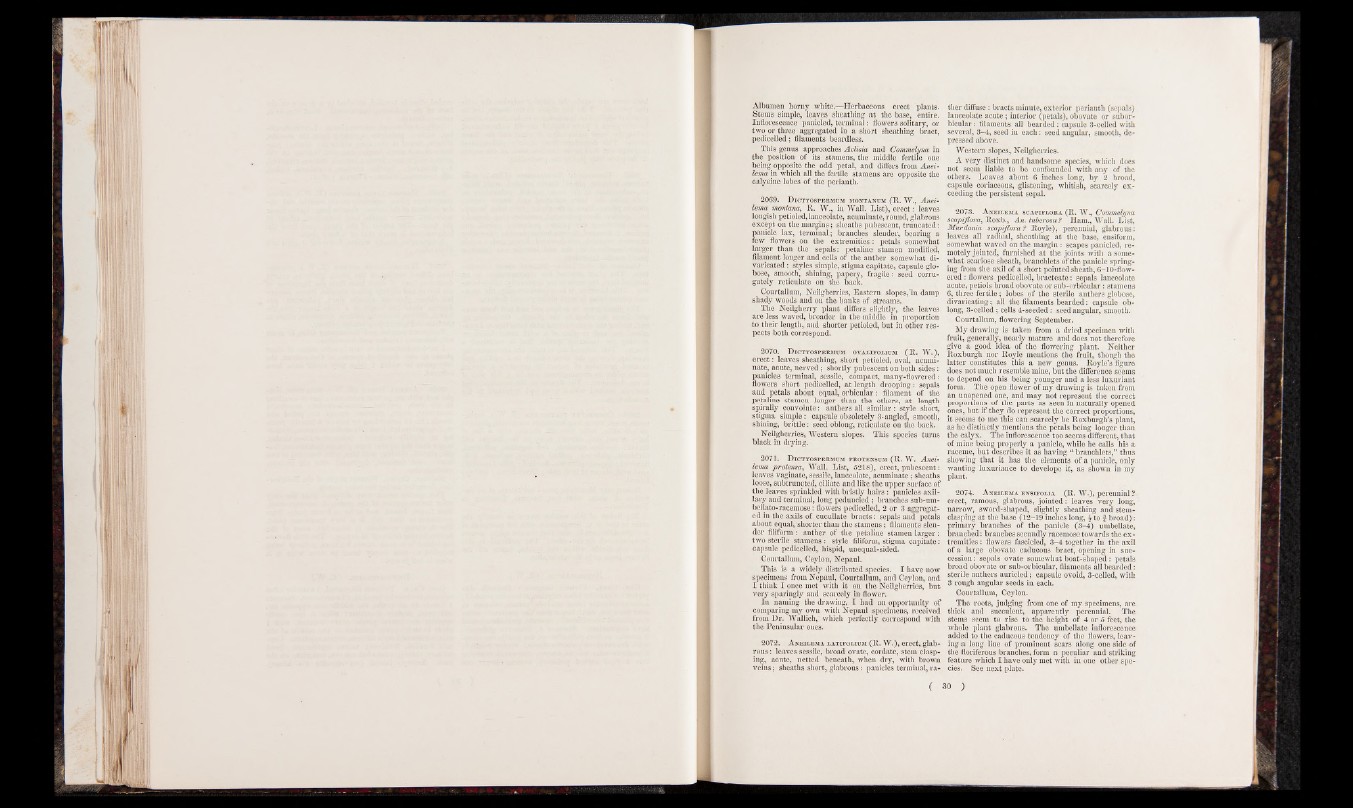
Albumen horny white.—Herbaceous erect plants.
Stems simple, leaves sheathing at the base, entire.
Inflorescence panicled, terminal: flowers solitary, or
two or three aggregated in a short sheathing bract,
pedicelled; filaments beardless.
This genus approaches Aclisia and Commelyna in
the position of its stamens, the middle fertile one
being opposite the odd petal, and differs from Anei-
lema in which all the fertile stamens are opposite the
calycine lobes of the perianth.
2069. D ictyospebmum montanum (R. W., Anei-
lema montana, R. W., inWall. List), ere c t: leaves
longish petioled, lanceolate, acuminate, round, glabrous
except on the margins; sheaths pubescent, truncated:
panicle lax, terminal; branches slender, bearing a
few flowers on the extremities: petals somewhat
larger than the sepals: petaline stamen modified,
filament longer and cells of the anther somewhat divaricated
: styles simple, stigma capitate, capsule globose,
smooth, shining, papery, fragile: seed corru-
gately reticulate on the back.
Courtallum, Neilgherries, Eastern slopes,"in damp
shady woods and on the banks of streams.
The Neilgherry plant differs slightly, the leaves
are less waved, broader in the middle in proportion
to their length, and shorter petioled, but in other respects
both correspond.
2070. D ictyospebmum oyALiFOLiuM (R . W.),
e re c t: leaves sheathing, short petioled, oval, acuminate,
acute, nerved; shortly pubescent on both sides:
panicles terminal, sessile, compact, many-flowered:
flowers short pedicelled, at length drooping: sepals
and petals about equal, orbicular: filament of the
petaline stamen longer than the others, at length
spirally convolute: anthers all similar: style short,
stigma simple: capsule obsoletely 3-angled, smooth,
shining, brittle: seed oblong, reticulate on the back.
Neilgherries, Western slopes. This species turns
black in drying.
2071. D ictyospebmum pbotensum (R. W. Anei-
lema protensa, Wall. List, 5218), erect, pubescent:
leaves vaginate, sessile, lanceolate, acuminate; sheaths
loose, snbtruncted, ciliate and like the upper surface of
the leaves sprinkled with bristly hairs: panicles axillary
and terminal, long peduncled; branches sub-um-
bellato-racemose: flowers pedicelled, 2 or 3 aggregated
in the axils of cucullate bracts: sepals and petals
about equal, 'shorter than the stamens; filaments slender
filiform: anther of the petaline stamen larg e r:
two sterile stamens: style filiform, stigma capitate:
capsule pedicelled, hispid, unequal-sided.
Courtallum, Ceylon, Nepaul.
This is a widely distributed species. I have now
specimens from Nepaul, Courtallum, and Ceylon, and
I think I once met with it on the Neilgherries, but
very sparingly and scarcely in flower.
In naming the drawing, I had an opportunity of
comparing my own with Nepaul specimens, received
from Dr. Wallich,' which perfectly correspond with
the Peninsular ones.
2072. Anellema latifolium (R. W .), erect, glabrous
: leaves sessile, broad ovate, cordate, stem clasping,
acute, netted beneath, when dry, with brown
veins; sheaths short, glabrous: panicles terminal, rather
difluse: bracts minute, exterior periauth (sepals)
lanceolate acute; interior (petals), obovate or subor-
bicular: filaments all bearded: capsule 3-celled with
several, 3-4, seed in each: seed angular, smooth, depressed
above.
Western slopes, Neilgherries.
A very distinct and handsome species, which does
not seem liable to be confounded with any of the
others. Leaves about 6 inches long, by 2 broad,
capsule coriaceous, glistening, whitish, scarcely exceeding
the persistent sepal.
2073. Aneilema scapiflora (R. W., Commelyna
scapiflora, Roxb., An. tuberosa ? Ham., Wall. List,
Murdania scapiflora? Royle), perennial, glabrous:
leaves all radical, sheathing at the base, ensiform,
somewhat waved on the margin: scapes panicled, remotely
jointed, furnished at the joints with a somewhat
scariose sheath, branchlets of the panicle springing
from the axil of a short pointed sheath, 6- 10-flow-
ered : flowers pedicelled, bracteate: sepals lanceolate
acute, petiols broad obovate or sub-orbicular: stamens
6, three fe rtile; lobes of the sterile anthers globose,
divaricating; all the filaments bearded: capsule oblong,
3-celled; cells 4-seeded: seed angular, smooth.
Courtallum, flowering September.
My drawing is taken from a dried specimen with
fruit, generally, nearly mature and does not therefore
give a good idea of the flowering plant. Neither
Roxburgh nor Royle mentions the fruit, though the
latter constitutes this a new genus. Royle’s figure
does not much resemble mine, but the difference seems
to depend on his being younger and a less luxuriant
form. The open flower of my drawing is taken from
an unopened one, and may not represent the correct
proportions of the parts as seen in naturally opened
ones, but if they do represent the correct proportions,
it seems to me this can scarcely be Roxburgh’s plant,
as he distinctly mentions the petals being longer than
the calyx. _ The inflorescence too seems different, that
of mine being properly a panicle, while he calls his a
raceme, but describes it as having “ branchlets,” thus
showing that it has the elements of a panicle, only
wanting luxuriance to develope it, as shown in my
plant.
2074. Aneilema ensifolia (R. W.), perennial ?
erect, ramous, glabrous, jointed: leaves very long,
narrow, sword-shaped, slightly sheathing and stem-
clasping at the base (12-19 inches long, £ to f broad):
primary branches of the panicle (3-4) umbellate,
branched: branches secundly racemose towards the extremities
: flowers fascicled, 3-4 together in the axil
of a large obovate caducous bract, opening in succession
: sepals ovate somewhat boat-shaped: petals
broad obovate or sub-orbicular, filaments all bearded:
sterile anthers auricled; capsule ovoid, 3-celled, with
3 rough angular seeds in each.
Courtallum, Ceylon.
The roots, judging from one of my specimens, are
thick and succulent, apparently perennial. The
stems seem to rise to the height of 4 or 5 feet, the
whole plant glabrous. The umbellate inflorescence
added to the caducous tendency of the flowers, leaving
a long line of prominent scars along one side of
the floriferous branches, form a peculiar and striking
feature which I have only met with in one other species.
See next plate.